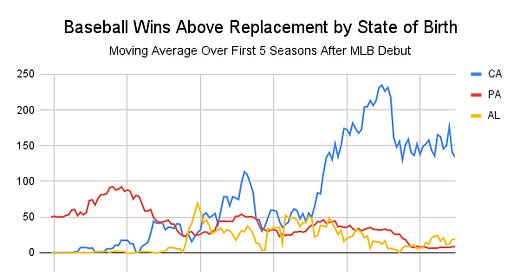The Civil War's Long Shadow Over Baseball
Baseball became the National Pastime because the Union won the Battle of Gettysburg.
Baseball became the National Pastime because it was played constantly by bored soldiers in Union Army camps during the Civil War. Bringing together men from across the North required the hammering out of rules disputes between the various local American versions of ball-and-bat games descended from English rounders, with the New York rules for Base Ball coming to be most popular with Midwesterners.
As evidence of how serious were hard feelings in the South for decades after the Civil War, boys in former Confederate states seldom played baseball. Although professional baseball leagues were organized in the North and Upper South as early as four years after the War, Southerners, who became fairly dominant in baseball by the 1930s, were seldom seen at the highest levels until the 20th Century. The first Hall of Famer born in one of the eleven Confederate states to debut in Major League Baseball was Ty Cobb, the Georgia Peach, who first played big league ball in 1905, 40 years after Appomattox.
You can do a quick and dirty look at how big a deal baseball was in various states in the past by looking at the debut date in the big leagues of native sons who went on to be selected for the Cooperstown Hall of Fame.
For example, among Union states, New York had 11 Hall of Famers who got their start in the 1800s, while Pennsylvania had 6 Hall of Famers who debuted before 1900.
Even distant California’s first native born Hall of Famer was Frank Chance of Tinkers to Evers to Chance, who debuted in 1898, followed by Harry Hooper in 1909.
Here are initial Hall of Famers and their year of debut for the eleven secessionist states:
Georgia: Ty Cobb, 1905, next was Bill Terry, 1923
Texas: Tris Speaker, 1907, then Rogers Hornsby 1915
South Carolina: Joe Jackson, 1908, would have made it, but Ben Taylor of the Negro Leagues, 1920, is the first in the Hall of Fame. First MLB star was Jim Rice, not until 1974.
Alabama: Joe Sewell, 1920, then Heinie Manush, 1923
Arkansas: Travis Jackson 1922, Dizzy Dean 1930
Florida: John Henry Lloyd, 1921 (Negro Leagues), Al Lopez 1928 (MLB, but he squeezed in in part as a manager), Steve Carlton 1965 (first Florida-born Hall of Famer as just an MLB player)
Louisiana: Ted Lyons, 1923, then Mel Ott, 1926.
Mississippi: Cool Papa Bell, 1922 (Negro Leagues — still only HoF from Mississippi)
North Carolina: Rick Ferrell, 1929
Tennessee: Turkey Stearnes of Negro Leagues, 1923, first MLB Hall of Famer: Todd Helton, 1997.
Virginia, Eppa Rixey, 1912. But Virginia strikes me as one of the real under-performers in baseball.
Among slave states that stayed in the Union:
Missouri: Pud Galvin, 1875, Jake Beckley, 1888, Clark Griffith, 1891
Maryland, Vic Willis, 1898, Home Run Baker, 1908, Babe Ruth 1914.
Kentucky, Earl Combs, 1924 (also had some 19th Century stars like Pete Browning, the Louisville Slugger, who drank too much to make the Hall of Fame)
Little Delaware: Current player Paul Goldschmidt might become Delaware’s first HoFer.
Here’s a more scientific way of looking at it with large sample sizes for three states: Pennsylvania (Civil War North), Alabama (Civil War South), and California (Sunbelt): take the year of debut for every player born in the state and calculate the moving average of their career Wins Above Replacement (a pretty good measure of contribution) over the next five seasons.
Pennsylvania (red line) dominates the early decades:
Then California (blue line) takes the lead in the Joe DiMaggio-Ted Williams interwar era.
Alabama is barely present until the 1920s, but then it rises up in the Willie Mays-Hank Aaron early postwar, before Alabama drops back as African Americans lose interest in baseball.
California becomes ever more dominant, peaking with Barry Bonds in the late 1980s before receding then stabilizing at a high level. Pennsylvania drops down as, perhaps, baseball fanatic families relocate to the SunBelt to play year round.
And in this century Alabama makes a slight comeback.
I ended the graph about a decade ago because my methodology doesn’t handle new players well, but Alabama’s Gunnar Henderson looks promising.
My guess is that baseball talent is becoming more regionalized in the Sunbelt. Recall how ball clubs were puzzled by New Jersey schoolboy Mike Trout, causing two dozen teams to skip over him in the draft. Their thinking appeared to be: He’s obviously the best baseball player in New Jersey, but how good is that? If he played ball in Arizona we’d be able to tell, but New Jersey is just weird.





https://x.com/briandoleary/status/1813669073093554409?s=46
I have always been unenthusiastic about team sports. Racing you either win or you don't. Latish in life I got a chance to watch the College World Series baseball and was quite taken how quickly the game moves under an hour time constraint.